El mejor Pais
"El mejor Pais" is a 3000 copies edition of which 50 numeroted and signed copies, 44 pages, cm, 2011 (c)Sabrina Amrani Gallery.
With the support of "El Pais" and assistance of Daphné Gastaldi, David Alonso, Carolina Morala Segret, Florencia Valdes Andino, Maïmiti Cazalis, Sophie Tardy Joubert, and Maria-José Solana.
-
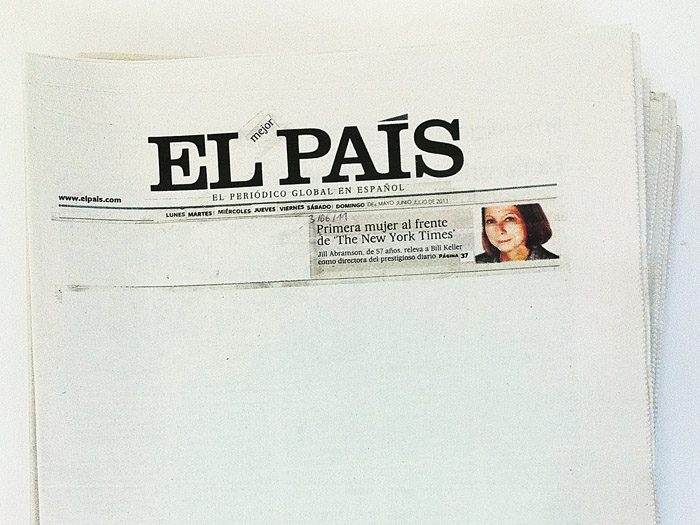
"El mejor Pais" 's front page, (September the 19th of 2011 version), 44 pages, 40 x 29 cm, 3000 offset printed copies among which 50 numbered and signed (c)Sabrina Amrani Gallery.
-
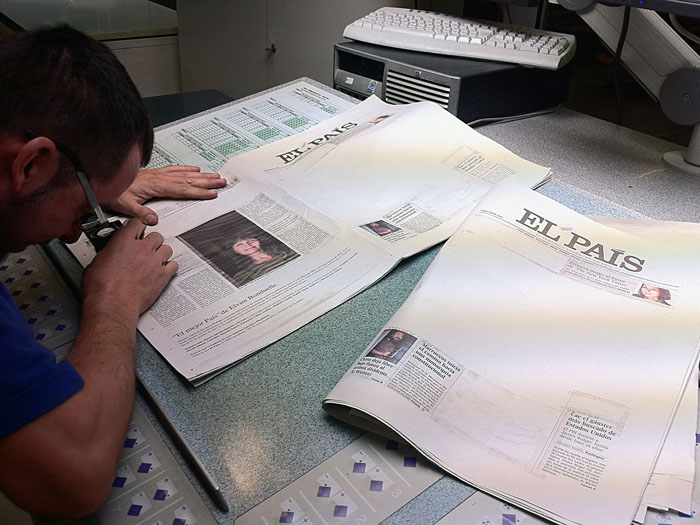
A technician examining "El mejor Pais" during the printing.
-
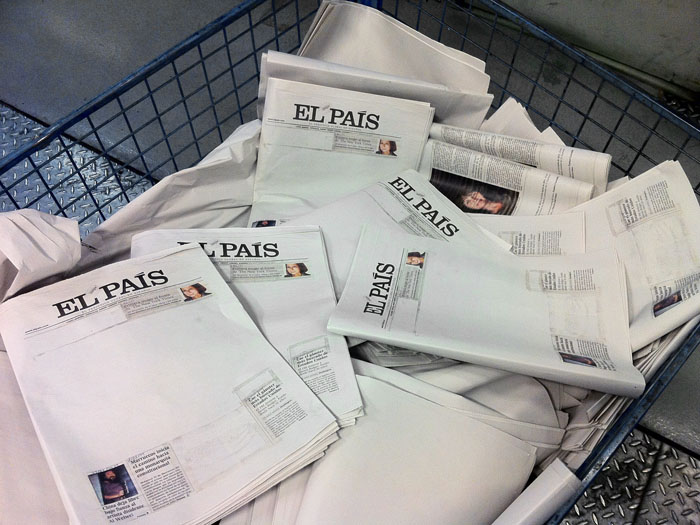
"El mejor Pais" en vrac, El Pais, Madrid, 2011.
-
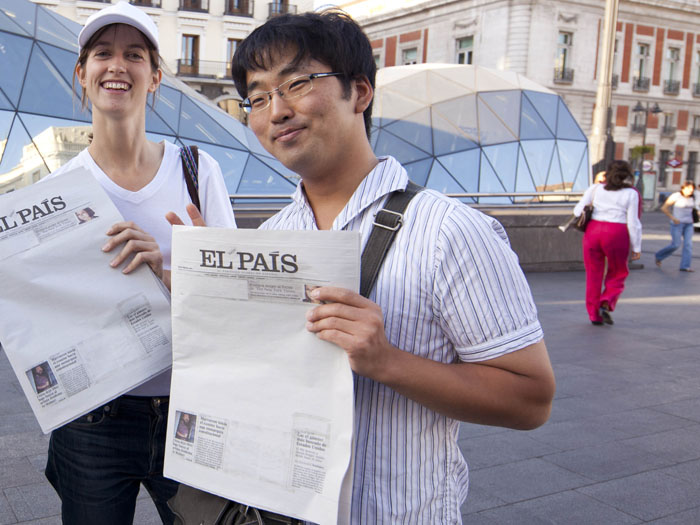
During the distribution-performance, at the Puerta del Sol (the Indignate's square), September the 21rst of 2011, Madrid.
-
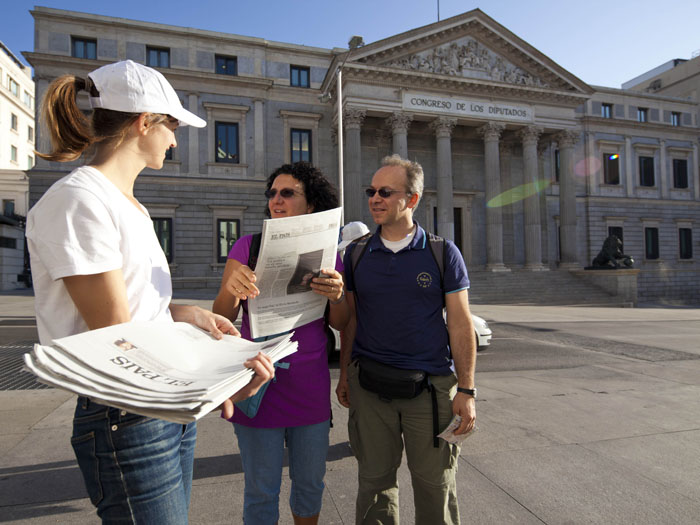
During the distribution-performance, in front of the Congress, September the 21rst of 2011, Madrid, Spain.
-
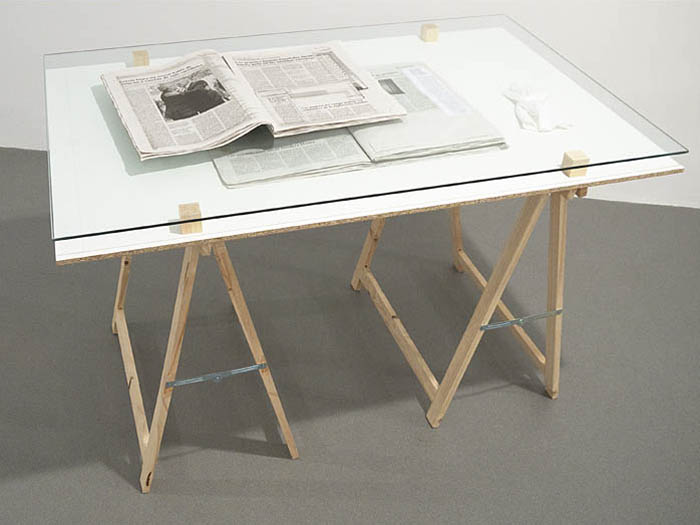
"El mejor Pais" original (under the glass) and "El mejor Pais" printed version (on the glass).
Installation at "Pour faire joli" personal exhibition, Sabrina Amrani Gallery, Madrid, Spain. -
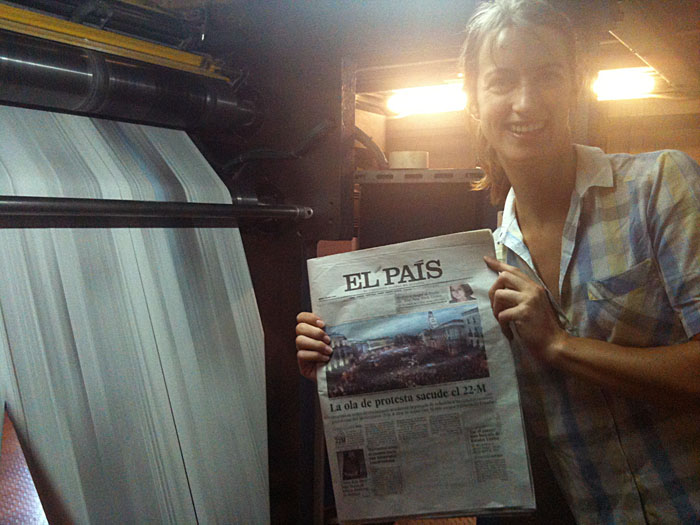
Elvire with "El mejor Pais" print of September the 16th of 2011, El Pais, Madrid, Spain.
-
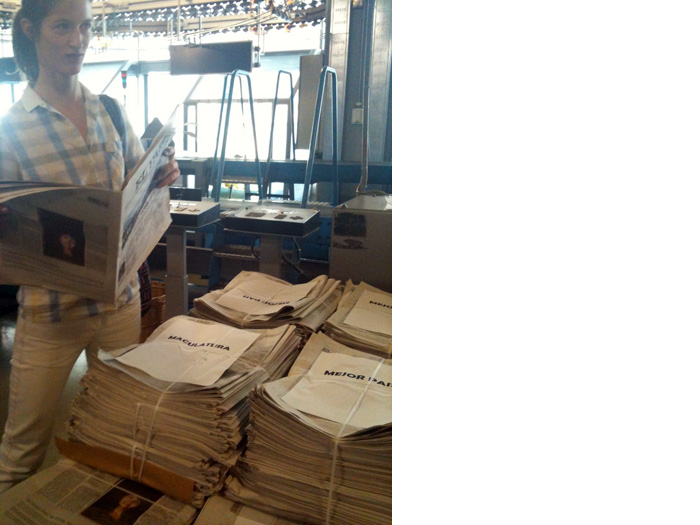
-
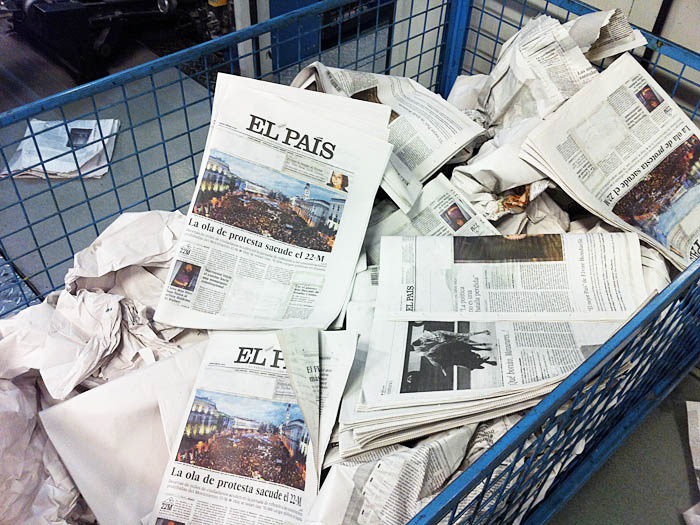
"El mejor Pais" in El Pais's bump bin, September the 16th of 2011 version.
Every time we come across more people who say that they are stopping to read the newspapers. They prefer to isolate themselves from the bad news, like who does not go to the doctor while the lump under the skin get the size of a soccer ball. But if you do not look does not mean they do not act. With the economic crisis the media has overreacted, they abused covers and dramatic messages. Every Friday the world ends and every Monday there is another win for Barcelona or Real Madrid. Where do we stop ?
It is likely that over-dramatization of the analysts have finished digging the hole to proceed to the burial of the welfare project on which we went to work for many years and now seems to us an unattainable future perspective. On this, more than anything else, we should reflect on how we could take as many steps backward thinking that we were taking forward.
In comparative issues we have to be cautious. Every time I hear someone complain because kids today do not know fun or play I remember my father principal amusement in childhood was to put a rock in the scarf and herding among friends. Rafael Azcona used to swing a New Yorker cartoon every time someone foisted a sermon on how we were going to get worse. It showed two men of Palaeolithic and told one another: "Many complain of stress, pollution and modern life, but their life expectancy is 80 years and ours is no more than 30".
Some say that pessimism is a trick to sneak worst as irremediable. Keep it in mind. Last week, the young French Elvire Bonduelle produced a limited edition of this newspaper which presents a montage of good news released between May and August. If you did not get a copy of El mejor País, run to it. It may not reconciled yourself with either the reality or the media, but you will recognize that within our hand there are plenty of beautiful ways to transform the bad news in good.
David Trueba, El Pais, 27/09/2011
Un periódico solo de buenas noticias, gratis y a pie de calle
La artista Elvire Bonduelle repartió ayer 3.000 ejemplares de El Mejor País gratis y a pie de calle. Un diario de buenas noticias publicadas en EL PAÍS entre el 1 de mayo y el 15 de agosto. Forma parte de la muestra Pour faire joli (Para hacerlo bonito), que se exhibe hasta el 22 de octubre en la sala Sabrina Amrani.
David Trueba, El Pais, 22/09/2011
"Leer el periódico empezó a ser muy doloroso". Elvire Bonduelle (París, 1981) resume así su propuesta artística. Una iniciativa que huye de las tragedias diarias para centrarse en el lado positivo de la vida. El proyecto se materializa en el periódico El Mejor País, un collage de buenas noticias publicadas en EL PAÍS entre el 1 de mayo y el 15 de agosto.
La liberación del artista disidente chino Ai Weiwei o el descenso del abandono escolar son algunas de las informaciones recopiladas por la artista francesa, que incide en que el resultado final tiene mucho de subjetividad. "Siete colaboradores me ayudaron a reunir las noticias. Luego, de entre todas, yo hice mi propia reselección", explica. La exposición Pour faire joli (Para hacer bonito) se inaugura mañana en la galería Sabrina Amrani (Madera, 23) de Madrid. Mañana, además, la propia autora repartirá 3.000 ejemplares de El Mejor País de forma gratuita en la calle de Atocha y en las plazas de Sol y Callao, entre las 8.30 y las 10.30. "Extra, extra. Solo buenas noticias. Es gratis", gritaba Bonduelle el año pasado en la estación parisiense de Bonne Nouvelle (Buena noticia). Una experiencia "alegre" que defiende la importancia de informarse para poder involucrarse en la vida política. La acción tiene su origen en la iniciativa Le Meilleur Monde (El Mejor Mundo) que Bonduelle realizó en París en junio de 2010 en colaboración con el periódico Le Monde. "Cuando me independicé me suscribí al diario, y aunque leer tantas malas noticias me chupaba la energía, creo que es necesario mantenerse conectado a la actualidad para participar en la sociedad". A pesar de la voluntad de la artista por reflejar informaciones positivas, un gran blanco abre el diario ante la falta de buenas noticias. Para la contraportada escoge a la diputada israelí Einat Wilf, que como Bonduelle se muestra optimista: "La política no es una batalla perdida".
Samira Saleh, El Pais, 20/09/2011
Interview with Martin Higgins, for The Eternities, 2011
News production is a highly subjective art. First of all, it is a production. The vast majority of human events go unnoticed by the media lens, and a large proportion of what could quite legitimately be included ends up on the cutting room floor.The French artist, Elvire Bonduelle, has mirrored the selectivity of this process by her creation this year of a special edition of the Spanish newspaper, El País, consisting only of positive news stories, which she has called El mejor País (The best Country). In total, 3,000 copies of the newspaper were printed as part of her 'Pour faire joli' ('To make nice') exhibition and distributed on the streets of Madrid to unsuspecting members of the public.
What inspired your newspaper project? Were there any differences to your Le Monde project of last year?
I was first inspired by the bad energies I realised I was eating everyday just by reading the news. But I didn't want to stop [reading]. I wanted to be aware of what happens in the world. I don't want to be an artist who stays apart of the world and does some crazy things in their studio.Le Monde is 'my' newspaper, I read it almost everyday, so when I did 'Le meilleur Monde' ('The best World') it was something very close to me. El mejor País was a collaboration work as I am not Spanish and needed some clues to understand national politics. So it became more global and mixed various subjectivities, mine, those of my collaborators, and then also El País's as they were deeply involved in the project and asked to remove two articles.How long did it take to fill each newspaper with positive stories?Le meilleur Monde and El mejor País both took me about three and a half months each, which means it takes approximately 100 issues to make a positive one! One per cent! I didn't intend to criticize the media, but in the end it became a real subject. For example, on front pages there is almost never good news. Does it mean good news doesn't sell? So we readers must be partly responsible for it.It was long and hard work as I decided to read each article of each issue during the 100 day period, and then tried to create a paper with exactly the same layout. Sometimes there are some white spaces as I didn't want to put advertisements nor to publish articles that were not so positive. In the end, most choices are conflicts of love and duty. It's a crazy thing!
What sort of response have you had both from both the newspapers and your audience?
Well ... I have to say it has been a great success for both 'best newspapers'! People are very enthusiastic about the concept. They all seem to be suffering from too much bad news that flows day by day. And they want to know more. They want to see it for real and check its positivity. Most of the time they agree with the choices made. Sometimes they ask, "Why this article ?" A polemic begins, and people realize that the whole project is very subjective. Then some ask which kind of news is the most difficult to find, and why some articles are so scary about the actual state of things, even if full of hope. But they all ask for more. They say they would read it each week if only it could be a weekly newspaper!
Can you explain a little about the ‘Cravaches’ ('Whips') installation in your exhibition, which replaced with whips the shafts that normally protect complementary newspapers in bars and cafes?
Yes, newspapers become a masochistic tool with the whips. I like the idea of increasing one's power by reading daily news. I actually don't want to quit reading it. Reading daily news is the active way of being aware of what happens in the world, it is voluntarily facing the truth of things that happen, including extreme violence.The person who tells you some news will surely, possibly unconsciously, add their subjectivity. And we don't need to add more subjectivity to news as there is already that of the media's. The journalists at the scene have the power, we only have leftovers. But the more power you can get you should take as it makes you stronger to face reality, to choose what you want to be, in which world you want to live, in order to be happy. One has to try hard to take part in democracy. We have to use the little freedom, the little power we still have to choose how we want the world to be. And it's a tough thing to accomplish because to do so you have to be aware of what politics says, and plan and do, or not. I am sure reading the news helps a bit!
How does this work fit into your wider work and the ‘Pour faire joli' ('To make nice') exhibition?
Well my work is, from the very beginning, entirely directed by a kind of 'quest for happiness'. It happens to be any kind of pieces, objects, drawings, videos, installations, anything I imagine and create in order to make life more ... pleasant.I often do stuff that fits in at home which can be useful, such as furniture, in order to make life more comfortable. I decided art should be more important and present in our everyday lives, as it can be powerful sometimes! But it should not be too sacred: for example, I'm doing many chairs for a long time because it is our adaptors to Earth, and also because I like the idea that people will first look at it as a piece of art, with respect, admiration - maybe more - and then simply sit on it.I did these two best newspaper to bring more happiness in our lives by sharing good news. The greatest part of these two experiences is the performances: to go on the street and distribute these special issues by shouting "Le meilleur Monde! Or El mejor Pais! Only good news! It's for free!" People take it, take a few steps and turn back, "Only good news? It's not possible!"
I hope I'll be soon shouting in English, "The best _____! Only good news! it 's for free!"